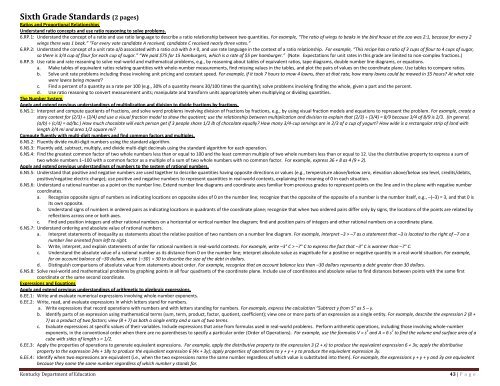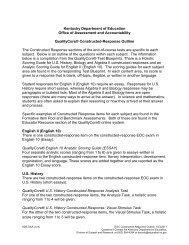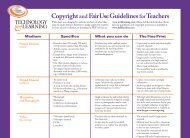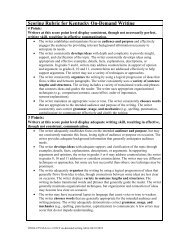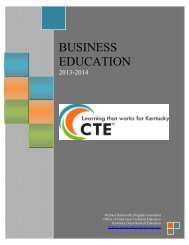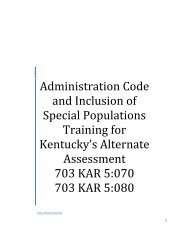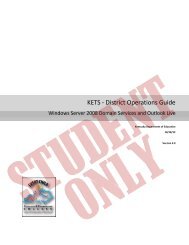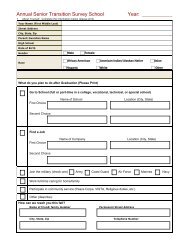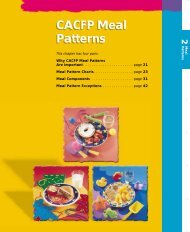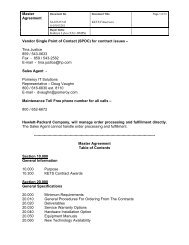Standards with Progressions grades K-HS v. 1.3 - Kentucky ...
Standards with Progressions grades K-HS v. 1.3 - Kentucky ...
Standards with Progressions grades K-HS v. 1.3 - Kentucky ...
- No tags were found...
You also want an ePaper? Increase the reach of your titles
YUMPU automatically turns print PDFs into web optimized ePapers that Google loves.
Sixth Grade <strong>Standards</strong> (2 pages)<br />
Ratios and Proportional Relationships<br />
Understand ratio concepts and use ratio reasoning to solve problems.<br />
6.RP.1: Understand the concept of a ratio and use ratio language to describe a ratio relationship between two quantities. For example, “The ratio of wings to beaks in the bird house at the zoo was 2:1, because for every 2<br />
wings there was 1 beak.” “For every vote candidate A received, candidate C received nearly three votes.”<br />
6.RP.2: Understand the concept of a unit rate a/b associated <strong>with</strong> a ratio a:b <strong>with</strong> b ≠ 0, and use rate language in the context of a ratio relationship. For example, “This recipe has a ratio of 3 cups of flour to 4 cups of sugar,<br />
so there is 3/4 cup of flour for each cup of sugar.” “We paid $75 for 15 hamburgers, which is a rate of $5 per hamburger.” (Note: Expectations for unit rates in this grade are limited to non-complex fractions.)<br />
6.RP.3: Use ratio and rate reasoning to solve real-world and mathematical problems, e.g., by reasoning about tables of equivalent ratios, tape diagrams, double number line diagrams, or equations.<br />
a. Make tables of equivalent ratios relating quantities <strong>with</strong> whole-number measurements, find missing values in the tables, and plot the pairs of values on the coordinate plane. Use tables to compare ratios.<br />
b. Solve unit rate problems including those involving unit pricing and constant speed. For example, if it took 7 hours to mow 4 lawns, then at that rate, how many lawns could be mowed in 35 hours At what rate<br />
were lawns being mowed<br />
c. Find a percent of a quantity as a rate per 100 (e.g., 30% of a quantity means 30/100 times the quantity); solve problems involving finding the whole, given a part and the percent.<br />
d. Use ratio reasoning to convert measurement units; manipulate and transform units appropriately when multiplying or dividing quantities.<br />
The Number System<br />
Apply and extend previous understandings of multiplication and division to divide fractions by fractions.<br />
6.NS.1: Interpret and compute quotients of fractions, and solve word problems involving division of fractions by fractions, e.g., by using visual fraction models and equations to represent the problem. For example, create a<br />
story context for (2/3) ÷ (3/4) and use a visual fraction model to show the quotient; use the relationship between multiplication and division to explain that (2/3) ÷ (3/4) = 8/9 because 3/4 of 8/9 is 2/3. (In general,<br />
(a/b) ÷ (c/d) = ad/bc.) How much chocolate will each person get if 3 people share 1/2 lb of chocolate equally How many 3/4-cup servings are in 2/3 of a cup of yogurt How wide is a rectangular strip of land <strong>with</strong><br />
length 3/4 mi and area 1/2 square mi<br />
Compute fluently <strong>with</strong> multi-digit numbers and find common factors and multiples.<br />
6.NS.2: Fluently divide multi-digit numbers using the standard algorithm.<br />
6.NS.3: Fluently add, subtract, multiply, and divide multi-digit decimals using the standard algorithm for each operation.<br />
6.NS.4: Find the greatest common factor of two whole numbers less than or equal to 100 and the least common multiple of two whole numbers less than or equal to 12. Use the distributive property to express a sum of<br />
two whole numbers 1–100 <strong>with</strong> a common factor as a multiple of a sum of two whole numbers <strong>with</strong> no common factor. For example, express 36 + 8 as 4 (9 + 2).<br />
Apply and extend previous understandings of numbers to the system of rational numbers.<br />
6.NS.5: Understand that positive and negative numbers are used together to describe quantities having opposite directions or values (e.g., temperature above/below zero, elevation above/below sea level, credits/debits,<br />
positive/negative electric charge); use positive and negative numbers to represent quantities in real-world contexts, explaining the meaning of 0 in each situation.<br />
6.NS.6: Understand a rational number as a point on the number line. Extend number line diagrams and coordinate axes familiar from previous <strong>grades</strong> to represent points on the line and in the plane <strong>with</strong> negative number<br />
coordinates.<br />
a. Recognize opposite signs of numbers as indicating locations on opposite sides of 0 on the number line; recognize that the opposite of the opposite of a number is the number itself, e.g., –(–3) = 3, and that 0 is<br />
its own opposite.<br />
b. Understand signs of numbers in ordered pairs as indicating locations in quadrants of the coordinate plane; recognize that when two ordered pairs differ only by signs, the locations of the points are related by<br />
reflections across one or both axes.<br />
c. Find and position integers and other rational numbers on a horizontal or vertical number line diagram; find and position pairs of integers and other rational numbers on a coordinate plane.<br />
6.NS.7: Understand ordering and absolute value of rational numbers.<br />
a. Interpret statements of inequality as statements about the relative position of two numbers on a number line diagram. For example, interpret –3 > –7 as a statement that –3 is located to the right of –7 on a<br />
number line oriented from left to right.<br />
b. Write, interpret, and explain statements of order for rational numbers in real-world contexts. For example, write –3° C > –7° C to express the fact that –3° C is warmer than –7° C.<br />
c. Understand the absolute value of a rational number as its distance from 0 on the number line; interpret absolute value as magnitude for a positive or negative quantity in a real-world situation. For example,<br />
for an account balance of –30 dollars, write |–30| = 30 to describe the size of the debt in dollars.<br />
d. Distinguish comparisons of absolute value from statements about order. For example, recognize that an account balance less than –30 dollars represents a debt greater than 30 dollars.<br />
6.NS.8: Solve real-world and mathematical problems by graphing points in all four quadrants of the coordinate plane. Include use of coordinates and absolute value to find distances between points <strong>with</strong> the same first<br />
coordinate or the same second coordinate.<br />
Expressions and Equations<br />
Apply and extend previous understandings of arithmetic to algebraic expressions.<br />
6.EE.1: Write and evaluate numerical expressions involving whole-number exponents.<br />
6.EE.2: Write, read, and evaluate expressions in which letters stand for numbers.<br />
a. Write expressions that record operations <strong>with</strong> numbers and <strong>with</strong> letters standing for numbers. For example, express the calculation “Subtract y from 5” as 5 – y.<br />
b. Identify parts of an expression using mathematical terms (sum, term, product, factor, quotient, coefficient); view one or more parts of an expression as a single entity. For example, describe the expression 2 (8 +<br />
7) as a product of two factors; view (8 + 7) as both a single entity and a sum of two terms.<br />
c. Evaluate expressions at specific values of their variables. Include expressions that arise from formulas used in real-world problems. Perform arithmetic operations, including those involving whole-number<br />
exponents, in the conventional order when there are no parentheses to specify a particular order (Order of Operations). For example, use the formulas V = s 3 and A = 6 s 2 to find the volume and surface area of a<br />
cube <strong>with</strong> sides of length s = 1/2.<br />
6.EE.3: Apply the properties of operations to generate equivalent expressions. For example, apply the distributive property to the expression 3 (2 + x) to produce the equivalent expression 6 + 3x; apply the distributive<br />
property to the expression 24x + 18y to produce the equivalent expression 6 (4x + 3y); apply properties of operations to y + y + y to produce the equivalent expression 3y.<br />
6.EE.4: Identify when two expressions are equivalent (i.e., when the two expressions name the same number regardless of which value is substituted into them). For example, the expressions y + y + y and 3y are equivalent<br />
because they name the same number regardless of which number y stands for.<br />
<strong>Kentucky</strong> Department of Education<br />
43 | P a g e


